Sukhoi Su-24
From Wikipedia, the free encyclopedia
| Su-24 | |
|---|---|
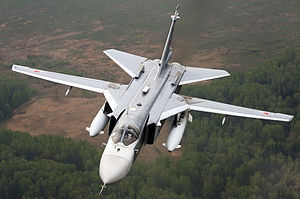 |
|
| Su-24M of the Russian Air Force, May 2009 | |
| Role | All-weather bomber |
| Manufacturer | Sukhoi |
| Designer | Ye. S. Felsner from 1985 – L.A. Logvinov[1] |
| First flight | T-6: 2 July 1967 T-6-2I: 17 January 1970 |
| Introduction | 1974 |
| Status | In service |
| Primary users | Russian Air Force Ukrainian Air Force Kazakh Air Force Islamic Republic of Iran Air Force |
| Produced | 1967–1993[1] |
| Number built | Approximately 1,400 |
| Unit cost | |
Contents
Development
Background
One of the conditions for accepting the Sukhoi Su-7B into service in 1961 was the requirement for Sukhoi to develop an all-weather variant capable of precision air strikes. Preliminary investigations with S-28 and S-32 aircraft revealed that the basic Su-7 design was too small to contain all the avionics required for the mission.[3] OKB-794 was tasked with developing an advanced nav/attack system, codenamed Puma, which would be at the core of the new aircraft.[1] That same year, the United States proposal for their new all-weather strike fighter would be the TFX. The resulting F-111 would introduce a variable-geometry wing for greatly increased payload, range, and low-level penetration capabilities.In 1962–1963, Sukhoi initially set out to build an aircraft without the complexity of moving wings like the F-111.[4] It designed and built a mockup of S-6, a delta wing aircraft powered by two Tumansky R-21F-300 turbojet engines and with a crew of two in a tandem arrangement. The mockup was inspected but no further work was ordered due to lack of progress on the Puma hardware.[3]
In 1964, Sukhoi started work on S-58M. The aircraft was supposed to represent a modification of the Sukhoi Su-15 interceptor (factory designation S-58). In the meantime, revised Soviet Air Force requirements called for a low-altitude strike aircraft with STOL capability. A key feature was the ability to cruise at supersonic speeds at low altitude for extended periods of time in order to traverse enemy air defenses.[3] To achieve this, the design included two Tumansky R-27F-300 afterburning turbojets for cruise and four Kolesov RD-36-35 turbojets for STOL performance. Side-by-side seating for the crew was implemented since the large Orion radar antennas required a large frontal cross-section.[3] To test the six-engine scheme, the first Su-15 prototype was converted into S-58VD flying laboratory which operated in 1966–1969.[3]
Design phase
T-6-1
By 1967, the F-111 had entered service and demonstrated the practical advantages and solutions to the technical problems of a swing-wing design. On 7 August 1968, the OKB was officially tasked with investigating a variable geometry wing for the T-6. The resulting T-6-2I first flew on 17 January 1970 with Ilyushin at the controls. The subsequent government trials lasted until 1974, dictated by the complexity of the on-board systems.[3] The day or night and all-weather capability was achieved – for the first time[3] in Soviet tactical attack aircraft – thanks to the Puma nav/attack system consisting of two Orion-A superimposed radar scanners for nav/attack, a dedicated Relyef terrain clearance radar to provide automatic control of flights at low and extremely low altitudes, and an Orbita-10-58 onboard computer.[1] The crew was equipped with Zvezda K-36D ejection seats, allowing the crew members to bail out at any altitude and flight speed, including during takeoff and landing.[1][3] The resulting design with a range of 3,000 km (about 2,000 miles) and payload of 8,000 kg (about 18,000 lb) was slightly smaller and shorter ranged than the F-111.
A pair of Russian Su-24Ms in flight, 2009
Upgrades
Surviving Su-24M models have gone through a life-extension and updating program, with GLONASS, upgraded cockpit with multi-function displays (MFDs), HUD, digital moving-map generator, Shchel helmet-mounted sights, and provision for the latest guided weapons, including R-73 (AA-11 'Archer') air-to-air missiles. It is unclear if the Su-24MR and Su-24MP will receive the cockpit and navigation upgrades. The upgraded aircraft are designated Su-24M2.Design
| This section needs additional citations for verification. (February 2010) |
Su-24M in flight, 2009
The Su-24 has two Saturn/Lyulka AL-21F-3A after-burning turbojet engines with 109.8 kN (24,700 lbf) thrust each, fed with air from two rectangular side mounted intakes with splitter plates/boundary-layer diverters.
In early Su-24 ("Fencer A" according to NATO) aircraft these intakes had variable ramps, allowing a maximum speed of 2,320 km/h (1,440 mph), Mach 2.18, at altitude and a ceiling of 17,500 m (57,400 ft). Because the Su-24 is used almost exclusively for low-level missions, the actuators for the variable intakes were deleted to reduce weight and maintenance. This has no effect on low-level performance, but absolute maximum speed and altitude are cut to Mach 1.35 and 11,000 m (36,100 ft).[5] The earliest Su-24 had a box-like rear fuselage, which was soon changed in production to a rear exhaust shroud more closely shaped around the engines in order to reduce drag. The revised aircraft also gained three side-by-side antenna fairings in the nose, a repositioned braking chute, and a new ram-air inlet at the base of the tail fin. The revised aircraft were dubbed "Fencer-B" by NATO, but did not merit a new Soviet designation.
Initial Su-24s had basic electronic countermeasures (ECM) equipment, with many Su-24s limited to the old Sirena radar-warning receiver with no integral jamming system. Later-production Su-24s had more comprehensive radar warning, missile-launch warning, and active ECM equipment, with triangular antennas on the sides of the intakes and the tip of the vertical fin. This earned the NATO designation "Fencer-C", although again it did not have a separate Soviet designation. Some "Fencer-C" and later Su-24M ("Fencer-D" by NATO) have large wing fence/pylons on the wing glove portion with integral chaff/flare dispensers; others have such launchers scabbed onto either side of the tail fin.
Operational history
Substantial numbers of ex-Soviet Su-24s remain in service with Azerbaijan, Kazakhstan, Russia, and Ukraine. In 2008, roughly 415 were in service with Russian forces, split 321 with the Russian Air Force and 94 with the Russian Navy.[7]The Russian Air Force will eventually replace the Su-24 with the Sukhoi Su-34.[8]
Soviet War in Afghanistan
The Soviet Union used some Su-24s in the Soviet war in Afghanistan, starting from 1984.Lebanese civil war
On October 13, 1990, Syrian Air Force jets entered Lebanese air space in order to strike General Michel Aoun's military forces. Seven Su-24 jets were used in this operation.[9]Operation Desert Storm
During Operation Desert Storm, the Iraqi Air Force evacuated 24 of its 30 Su-24MKs to Iran. Another five were destroyed on the ground, while the sole survivor remained in service after the war.Tajik and Afghan civil wars
Fencers were used by the Uzbek Air Force (UzAF) against Islamist and opposition forces operating from Afghanistan (which also had a civil war of its own going on), as part of a wider air campaign in support of the embattled government of Tajikistan during the 1992–97 civil war. An Su-24M was shot down on 3 May 1993 with an FIM-92 Stinger MANPADS fired by fundamentalists. Both Russian crew members were rescued.[10][11]In August 1999 Tajikistan protested over an alleged strike involving four UzAF Su-24s against Islamist militants in areas close to two mountain villages in the Jirgatol District that, despite not producing human casualties, killed some 100 head of livestock and set ablaze several crop fields. Tashkent denied the accusations.[12]
In the final stages of the 1996-2001 phase of the Afghan civil war, Uzbekistan launched airstrikes against Taliban positions in support of the Northern Alliance. During a mission to attack a Taliban armoured infantry unit near Heiratan, an UzAF Su-24 was shot down on 6 June 2001, killing both crew members.[13][14]
Second Chechen War
Su-24s were used in combat during the Second Chechen War performing bombing and reconnaissance missions. Up to four were lost, one due to hostile fire.On 4 October 1999, a Su-24 was shot down by a SAM while searching for the crash site of a downed Su-25. The pilot was killed while the navigator was taken prisoner.
2008 South Ossetia War
In August 2008, a low intensity conflict in the breakaway Georgian regions of Ossetia and Abkhazia, escalated to open war between Russia and Georgia.[15] Russian Su-24s were heavily involved in bombing strikes and reconnaissance flights over Georgia.[16]2011 Libyan civil war
During the 2011 Libyan civil war, on 5 March 2011, rebels shot down a Libyan Air Force Su-24MK during fighting around Ra's Lanuf with a ZU-23-2 antiaircraft gun. Both crew members died. A BBC reporter was on the scene soon after the event and filmed an aircraft part at the crash site showing the emblem of the 1124th squadron, flying the Su-24MK.[17][18][19]Syrian civil war
Starting in November 2012, 18 months after the beginning of the Syrian Civil War and four months after the beginning of air raids by fixed-wing SAF aircraft, Su-24 medium bombers were filmed attacking rebel positions.[20] The SAF suffered its first Su-24 loss, an upgraded MK2 version, to an Igla surface-to-air missile on 28 November 2012 near the town of Darat Izza in the Aleppo Governorate. One of the crew members, Col. Ziad Daud Ali, was injured and filmed being taken to a rebel field hospital.[21]Syrian Fencers have reportedly also been involved in near-encounters with NATO warplanes. The first of such incidents occurred in early September 2013, when Syrian Fencers of the 819th Squadron (launched from Tiyas airbase) flew low over the Mediterranean and approached the 14-mile air exclusion zone surrounding the British airbase in Akrotiri, Cyprus. The jets turned back before reaching the area due to two RAF Eurofighter Typhoons being scrambled to intercept them. Turkey also sent two F-16s. The Fencers were possibly testing the air defenses of the base (and their reaction time) in preparation for a possible military strike by the U.S, the United Kingdom and France in the aftermath of the chemical weapons attack in Ghouta, Damascus allegedly committed by the Syrian government.[22][23]
On September 23, 2014, a Syrian Su-24 was shot down by an Israeli Air Defense Command MIM-104D Patriot missile near Quneitra, after it had penetrated 800 meters into Israeli controlled airspace over the Golan Heights.[24] The missile hit the aircraft when it already re-entered into the Syrian air space.[25] Both crew members ejected safely and landed in Syrian territory.[26]
2015 Russian military operation in Syria
Main article: 2015 Russian Sukhoi Su-24 shootdown
Main article: Russian-led military intervention in Syria
The Russian air force's long-range striking power in the region comes
from the twelve Su-24M2 Fencer jets that Russia has sent to its base in
Latakia, Syria.[27]On 24 November 2015, a Russian Su-24M was shot down by two Turkish F-16s near the Turkey/Syrian border. Both of the crew ejected before the plane crashed in Syrian territory. Russia claimed that the jet had not left Syrian airspace while Turkey claims the jet entered their airspace and was warned 10-12 times before the plane was shot down.[28][29] A deputy commander in a Syrian Turkmen brigade claimed that his personnel shot and killed both crew while they were descending in their parachutes, while some Turkish officials subsequently stated that the crew was still alive.[30] The weapon systems officer was however rescued by Russian forces, while the pilot was killed by rebels along with a Russian marine involved in a rescue attempt. Russian president warned Turkey of serious consequences. It has been reported Russian figher jets would escort future bomber missions, and S-300 and S-400 advanced antiaircraft systems deployed in Syria in addition to a Russian antiaircraft cruiser were sent to Syria to protect Russian aircraft.[31][32]
2014 Ukrainian conflict
Main articles: 2014 pro-Russian unrest in Ukraine and List of Ukrainian aircraft losses during the 2014 pro-Russian unrest in Ukraine
On 2 July 2014, one Ukrainian Air Force
Su-24 was damaged by MANPADS fired by pro-Russian forces. One of the
engines was damaged, but the crew managed to return to base and land.
During landing a new fire started but it was extinguished by the ground
crew.[33]Initially identified as a Su-25, on 20 August 2014 a Ukrainian Su-24M was shot down by pro-Russian forces in the Lugansk region and confirmed by Ukrainian authorities who reported that the crew members ejected safely and were recovered.[34][35] On 21 August 2014, the downed plane was identified as a Su-24M.[36]
In late May 2015, a pair of Russian Fencers made a low pass over the USS Ross in the Black Sea.[37]
Variants
- Source: Sukhoi[3]
- S6[38]
- An early project in the gestation of the Su-24, like a meld of the Su-7 and Su-15.[38]
- T6-1
- The initial prototype with cropped delta wings and 4 RD-36-35 lift engines in the fuselage.[38]
- T6-2I / T6-3I / T6-4I
- Prototypes for the variable geometry Su-24 production aircraft.[38]
- Su-24
- The first production version, the armaments include Kh-23 and Kh-28 type air-to-ground guided missiles, together with R-55 type air-to-air guided missiles.[1] Manufactured 1971–1983.
- Su-24M ('Fencer-D')
- Work on upgrading the Su-24 was started in 1971, and included the addition of inflight refueling and expansion of attack capabilities with even more payload options. T-6M-8 prototype first flew on 29 June 1977, and the first production Su-24M flew on 20 June 1979. The aircraft was accepted into service in 1983. Su-24M has a 0.76 m (30 in) longer fuselage section forward of the cockpit, adding a retractable refueling probe, and a reshaped, shorter radome for the attack radar. It can be identified by the single nose probe in place of the three-part probe of earlier aircraft. A new PNS-24M inertial navigation system and digital computer were also added. A Kaira-24 laser designator/TV-optical quantum system (similar to the American Pave Tack) was fitted in a bulge in the port side of the lower fuselage, as well as Tekon track and search system (in pod), for compatibility with guided weapons, including 500 and 1,500kg laser-guided bombs and TV-guided bombs, and laser/TV-guided missiles Kh-25 and Kh-29L/T, anti-radar missiles Kh-58 and Kh-14 (AS-12 'Kegler') and Kh-59 (AS-13 'Kingbolt')/Kh-59M TV-target seeker guided missiles.[1] The new systems led to a reduction in internal fuel amounting to 85 l (22.4 US gal). Su-24M was manufactured in 1981–1993.[1]
- Su-24M2 ('Fencer-D')
- Next modernization of Su-24M introduced in 2000 with the “Sukhoi” program and in 1999 with the “Gefest” program. The modernized planes are equipped with new equipment and systems. As a result, they get new capabilities and improved combat efficiency, including new navigation system (SVP-24), new weapons control system, new HUD (ILS-31, like in Su-27SM or KAI-24) and expanding list of usable munitions (Kh-31A/P, Kh-59MK, KAB-500S). The last batch of the Sukhoi was delivered to the Russian VVS in 2009.[39] Modernization continues with the program “Gefest”. All frontline bombers Su-24 in the Central Military District received new sighting and navigation systems SVP-24 in 2013.[40]
- Su-24MK ('Fencer-D')
- Export version of the Su-24M with downgraded avionics and weapons capabilities. First flight 30 May 1987 as T-6MK, 17 May 1988 as Su-24MK. Manufactured 1988–1992, sold to Algeria, Iran, Iraq, Libya, and Syria.
- Su-24MR ('Fencer-E')
- Dedicated tactical reconnaissance variant. First flight 25 July 1980 as T-6MR-26, 13 April 1983 as Su-24MR. Entered service in 1983. Su-24MR retains much of the Su-24M's navigation suite, including the terrain-following radar, but deletes the Orion-A attack radar, the laser/TV system, and the cannon in favor of two panoramic camera installations, 'Aist-M' ('Stork') TV camera, RDS-BO 'Shtik' ('Bayonet') side-looking airborne radar (SLAR), and 'Zima' ('Winter') infrared reconnaissance system. Other sensors are carried in pod form. Manufactured 1983–1993.[1]
- Su-24MP ('Fencer-F')
- Dedicated electronic signals intelligence (ELINT) variant, intended to replace the Yak-28PP 'Brewer-E'. First flight 14 March 1980 as T-6MP-25, 7 April 1983 as Su-24MP. The Su-24MP has additional antennas for intelligence-gathering sensors, omitting the laser/TV fairing, but retaining the cannon and provision for up to four R-60 (AA-8) missiles for self-defense. Only 10 were built.[1]
Operators
Su-24 operators as of 2015. (Blue) Former operators (Red)
An Su-24M2 of the Russian Air Force.
An Su-24M of the Belarusian Air Force.
An IRIAF Su-24MK.
An Su-24MR of the Ukrainian Air Force.
 Algeria
Algeria- Algerian Air Force – 23 Su-24MKs, some upgraded to the M2 standard. 4 Su-24MRs.[41][42][43][44]
 Iran
Iran- Islamic Republic of Iran Air Force – 30 Su-24MKs were in service as of January 2013.[45] 24 Iraqi examples were evacuated to Iran during the 1991 Gulf War and were put in service with the IRIAF. Iran possibly, purchased other Su-24s from Russia or other, former Soviet States. Iran tested domestically produced, anti-radar smart missiles carried by Su-24 aircraft in September 2011, the IRIAF's Deputy Commander, General Mohammad Alavi said, according to IRINN TV.[46]
 Kazakhstan
Kazakhstan
- Kazakhstan Air Force - 25 Su-24 in service[47]
- Russian Air Force – 251 Su-24Ms, 40 Su-24M2s and 79 Su-24MRs were in service in 2011.[48]
- Russian Naval Aviation – 18 were in service in 2012.[49]
 Syria
Syria- Syrian Arab Air Force – 22 received. 20 Su-24MKs from the Soviet Union, 1 Su-24MK and 1 Su-24MR from Libya.[citation needed] 20 were in service in January 2013.[45] All the Su-24MKs have been upgraded to Su-24M2 standard, between 2009 and 2013. The contract for that was signed in 2009 and the upgrade started in 2010.
 Sudan
Sudan- Up to twelve, ex-Belarusian Air Force Su-24s were transferred to Sudan Air Force in 2013.[50]
 Ukraine
Ukraine- Ukraine Air Force received 120 Su-24s. Only 25 were in service, 95 were in storage. [clarification needed][51]
Notable accidents
- On 19 December 2008, a Russian Air Force Su-24M crashed near the southwest Russian city of Voronezh. The crew members ejected. Preliminary information indicates the crash was caused by a malfunction in the aircraft's flight control system.[52]
- On 13 February 2012, a Russian Air Force Su-24 crashed in Kurgan region. Both crew members ejected safely. Engine failure was stated as the probable cause of the crash.[53]
- On 30 October 2012, a Russian Air Force Su-24M crashed in Chelyabinsk Oblast, Russia. During the flight the nose cone fractured. After attempting an emergency landing, the crew of two flew to open territory and safely ejected. A regional government website stated that emergency was the result of aircraft control system failure. Flights of Su-24 were suspended at the Shagol base.[54]
- On 21 March 2014, a Ukrainian Air Force Su-24M belonging to the 7th Brigade crashed during approach for landing near Starokonstantinov in the Khmelnitsky region, Ukraine. Both crew members ejected safely.[55]
- On 13 October 2014, an Algerian Air Force Su-24 crashed during a training flight killing both crew members[56]
- On 6 July, 2015, a Russian Air Force Su-24 crashed outside of Khabarovsk in Russia's Far East killing both crew members. [57]
Specifications (Su-24MK)
Sukhoi Su-24MR at Kubinka airbase
- Crew: Two (pilot and weapons system operator)
- Length: 22.53 m (73 ft 11 in)
- Wingspan: 17.64 m extended, 10.37 m maximum sweep (57 ft 10 in / 34 ft 0 in)
- Height: 6.19 m (20 ft 4 in)
- Wing area: 55.2 m² (594 ft²)
- Empty weight: 22,300 kg (49,165 lb)
- Loaded weight: 38,040 kg (83,865 lb)
- Max. takeoff weight: 43,755 kg (96,505 lb)
- Powerplant: 2 × turbojets
- Dry thrust: 75 kN (16,860 lbf) each
- Thrust with afterburner: 109.8 kN (24,675 lbf) each
- Fuel capacity: 11,100 kg (24,470 lb)
- Maximum speed: 1,315 km/h (710 kn, 815 mph, Mach 1.08) at sea level; 1,654 km/h (Mach 1.35 ) at high altitude
- Combat radius: 615 km in a low-flying (lo-lo-lo) attack mission with 3,000 kg (6,615 lb) ordnance and external tanks ()
- Ferry range: 2,775 km (1,500 nm, 1,725 mi)
- Service ceiling: 11,000 m (36,090 ft)
- Rate of climb: 150 m/s (29,530 ft/min)
- Wing loading: 651 kg/m² (133 lb/ft²)
- Thrust/weight: 0.60
- G-force limit: 6 g
- Takeoff roll: 1,550 m (5,085 ft)
- Landing roll: 1,100 m (3,610 ft)
- 1 × onboard 23 mm GSh-6-23 cannon, 500 rounds of ammunition.
- Up to 8,000 kg (17,640 lb) ordnance on 8 hardpoints, including up to 4 × Kh-23/23M radio-command missiles; up to 4 × Kh-25ML laser-guided missiles; up to 2 × Kh-28, Kh-58E or Kh-58E-01 or Kh-31P ARMS; up to 3 × Kh-29L/T laser/TV-guided short-range air-to-surface missiles; up to 2 × Kh-59 or Kh-59ME TV-command guided missiles, Kh-31A anti-ship missiles, S-25LD laser-guided missiles, KAB-500KR TV-guided and KAB-500L laser guided bombs.
- Unguided rocket launchers with 240 mm S-24B rockets or 340 mm S-25-OFM rockets.
- Other weapon options include general-purpose bombs AB-100, AB-250 M54 or M62 and AB-500M-54, thermobaric bombs ODAB-500M, cluster bombs RBK-250 or RBK-500, small-size cargo pods KMGU-2, external gun pods SPPU-6, external fuel tanks PTB-2,000 (1,860 l) or PTB-3,000 (3,050 l) and tactical nuclear bombs.
- 2 × R-60 or R-60MK air-to-air missiles are normally carried for self-defense; upgraded aircraft can carry R-73E missiles as well.
See also
- Aircraft of comparable role, configuration and era
References
- Notes
- Wilson 2000, p. 130.
- Bibliography
- Antonov, Vladimir, et al. Okb Sukhoi: A History of the Design Bureau and Its Aircraft. Leicester, UK: Midland, 1996. ISBN 1-85780-012-5.
- Eden, Paul (ed.). The Encyclopedia of Modern Military Aircraft. London: Amber Books, 2004. ISBN 1-904687-84-9.
- Gordon, Yefim. Sukhoi Su-24. New York: IP Media, Inc., 2005. ISBN 1-932525-01-7.
- Wilson, Stewart. Combat Aircraft since 1945. Fyshwick, Australia: Aerospace Publications, 2000. ISBN 1-875671-50-1.
Further reading
- Air Forces Monthly, September 2015 (Iranian Su-24 force)
External links
| Wikimedia Commons has media related to Sukhoi Su-24. |
- Su-24 page on Sukhoi's site
- Su-24 page on Airforce-Technology.com
- Su-24 page on AerospaceWeb.org
- Su-24 page on militaryfactory.com
|
||||||||||||||||||||||||||||||||||
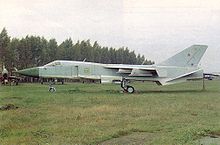


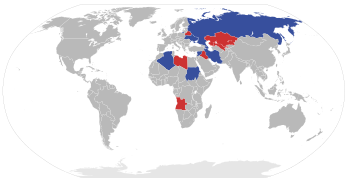



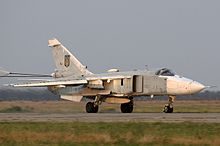

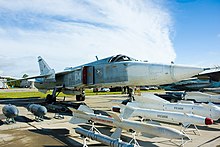
No comments:
Post a Comment